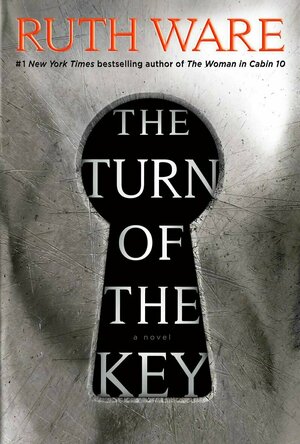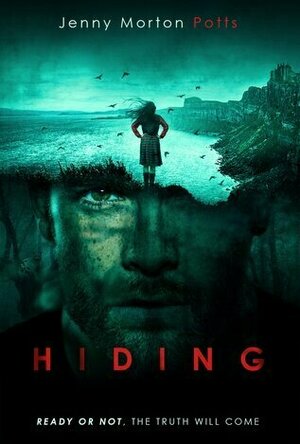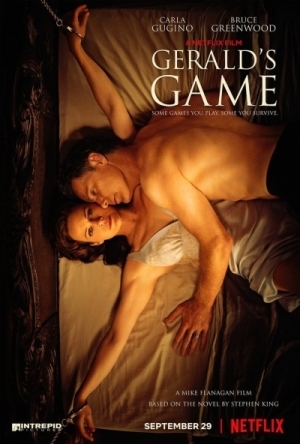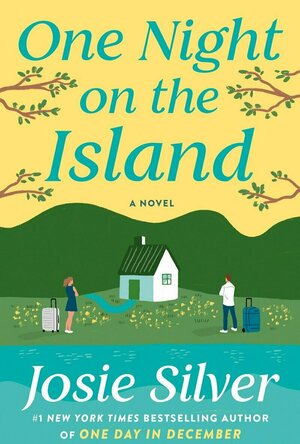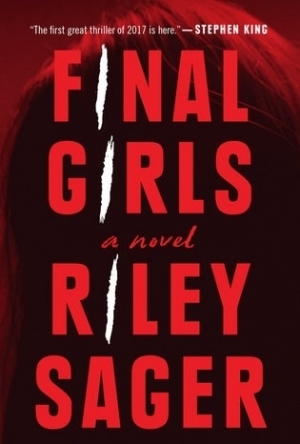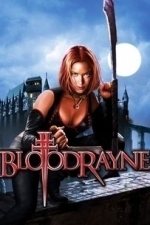Search
Eleanor (1463 KP) rated The Turn of The Key in Books
Dec 16, 2019
An Interesting Twist to a Familiar Tale
This suspense thriller was a close one for me but ultimately it just didn’t totally click. I listened to the audio version narrated by Inogen Church, who seemed to be a talented narrator just unfortunate that the person she was narrating was so irritating to me. The writing was of a high standard and I’ll certainly be looking at more of Ruth Ware’s work.
When Rowan takes a live-in nanny position in a remote Scottish she is soon faced with more than just the usual new nanny woes. The house has been converted into a modern all bells and whistles smart home, but it’s not exactly making life easier for Rowan. The book is told via the correspondence between Rowan and a solicitor from her prison cell following her arrest for the death of one of her charges. The result is a slow build of difficult circumstances from her perspective and a strong denial of any responsibility…. but what did happen?
This is a solid suspense thriller with plenty of creepy atmosphere in it and I can imagine some people will really love this book. For me, though I just kept getting a bit irritated. I’m not a big fan of kids (I know - burn the witch!!) and there are some prime examples of why that is in this book from the brats. Why someone would want to be a nanny is beyond me so Rowan is very hard to relate to. I really couldn’t care less about the routines of children. I’m also not a fan of having a narrator who constantly hints towards things not being as they seem but not clarifying until the “big reveal” troupe. So maybe just not the best book for me, in particular, to pick up.
Smart home things like speakers, voice-activated lights, fridges curtains, etc don’t do anything for me and the fact they added to the creepiness of Rowan’s situation was an interesting approach. Ultimately a book that many will love but just not my kinda story, so can’t get too pumped for it.
When Rowan takes a live-in nanny position in a remote Scottish she is soon faced with more than just the usual new nanny woes. The house has been converted into a modern all bells and whistles smart home, but it’s not exactly making life easier for Rowan. The book is told via the correspondence between Rowan and a solicitor from her prison cell following her arrest for the death of one of her charges. The result is a slow build of difficult circumstances from her perspective and a strong denial of any responsibility…. but what did happen?
This is a solid suspense thriller with plenty of creepy atmosphere in it and I can imagine some people will really love this book. For me, though I just kept getting a bit irritated. I’m not a big fan of kids (I know - burn the witch!!) and there are some prime examples of why that is in this book from the brats. Why someone would want to be a nanny is beyond me so Rowan is very hard to relate to. I really couldn’t care less about the routines of children. I’m also not a fan of having a narrator who constantly hints towards things not being as they seem but not clarifying until the “big reveal” troupe. So maybe just not the best book for me, in particular, to pick up.
Smart home things like speakers, voice-activated lights, fridges curtains, etc don’t do anything for me and the fact they added to the creepiness of Rowan’s situation was an interesting approach. Ultimately a book that many will love but just not my kinda story, so can’t get too pumped for it.
Phil Leader (619 KP) rated Hiding in Books
Nov 14, 2019
Keller Baye is the son of a murderer, a man he is about to watch die for his crime. A man who only wants one thing from his son: revenge.
Rebecca Brown is an orphan who has been brought up by relatives in a remote Scottish house and who's thirst for knowledge about her parents and the car crash in which they died only grows keener the less those around her are prepared to talk about it.
Despite the miles between these two people they are connected by a single thread, and that thread is set to bring them together and reveal the truth.
Roughly the first part of the book tells the backgrounds of the two main characters, gradually revealing one event at a time exactly who Baye and Brown are, what drives them and how the loss of their parents has had an indelible effect on both their lives. The second half relates the events that unfold once fate has driven them together.
Both characters feel very real, especially because of the care that has clearly gone into each of their back stories. Baye in particular could have just been a mere cipher of a child who went off the rails after his father went to prison. But that one event alone conspires with many others to shape Baye into the urgent tool of his father's revenge that he decides to be.
The stories of the character's very different childhoods is engrossing, effectively told a series of anecdotes. Baye delivering justice for his cat. Brown burning the playing cards. All these seem very real because they could really happen.
When the tension starts to build in the second half of the book it's not like a spring winding up; it is more like a boiler that is getting hotter and hotter and the pressure is rising all the time. It's not clear when something is going to break but it's clear that something will go very wrong at some point.
This is a superb thriller with an excellent plot, some very good twists and written at a perfect pace, fast enough to keep the momentum up but slow enough to ratchet the tension up at the end of each chapter. An easy 5 stars and a new J Morton Potts fan.
Rating: Scenes of sadistic violence and some others of a sexual nature
Rebecca Brown is an orphan who has been brought up by relatives in a remote Scottish house and who's thirst for knowledge about her parents and the car crash in which they died only grows keener the less those around her are prepared to talk about it.
Despite the miles between these two people they are connected by a single thread, and that thread is set to bring them together and reveal the truth.
Roughly the first part of the book tells the backgrounds of the two main characters, gradually revealing one event at a time exactly who Baye and Brown are, what drives them and how the loss of their parents has had an indelible effect on both their lives. The second half relates the events that unfold once fate has driven them together.
Both characters feel very real, especially because of the care that has clearly gone into each of their back stories. Baye in particular could have just been a mere cipher of a child who went off the rails after his father went to prison. But that one event alone conspires with many others to shape Baye into the urgent tool of his father's revenge that he decides to be.
The stories of the character's very different childhoods is engrossing, effectively told a series of anecdotes. Baye delivering justice for his cat. Brown burning the playing cards. All these seem very real because they could really happen.
When the tension starts to build in the second half of the book it's not like a spring winding up; it is more like a boiler that is getting hotter and hotter and the pressure is rising all the time. It's not clear when something is going to break but it's clear that something will go very wrong at some point.
This is a superb thriller with an excellent plot, some very good twists and written at a perfect pace, fast enough to keep the momentum up but slow enough to ratchet the tension up at the end of each chapter. An easy 5 stars and a new J Morton Potts fan.
Rating: Scenes of sadistic violence and some others of a sexual nature

Scanner Radio - iPad Edition
News and Social Networking
App
★★★★ The best selling Scanner Radio for the iPhone comes to the iPad! ★★★★ Listen to...
Gareth von Kallenbach (980 KP) rated The Last House on the Left (2009) in Movies
Aug 14, 2019
In 1972, horror icon Wes Craven made a name for himself by writing and directing a film called “The Last House on the Left.” The film was very controversial and helped launch a new genre of terror and suspense films that pushed the limits of the times. The film was notorious for its content which included rape, torture, humiliation, and violence and contains to this day some of the most disturbing images ever captured on film. In this age of remakes, prequels, and sequels, Wes Craven has stepped aside to produce a new version of his classic and this remake is sure to be as controversial and disturbing as the original was.
The film centers around 17 year old Mari Collingwood (Sara Paxton), who is taking time off from her competitive swimming and school to spend the summer with her parents Emma and John (Monica Potter and Tony Goldwyn), at their remote cabin in the woods. The family is coming to grips with the loss of their son, and Mari is anxious to spend some time with her friend Paige (Martha MacIssac), whom she has not seen in a while.
Despite concerns from her mother, Mari is given the keys to the car by her father and travels into town to see Paige. The two girls meet a boy named Justin (Spencer Treat Clark), and proceed to go back to his room to party. The three of them are having a great time until Justin’s father Krug (Garrett Dillahunt), as well as his uncle and father’s girlfriend return unexpectedly. Krug and the group are wanted convicts after a bloody escape that has left two officers dead and Krug and his family the subject of an intense manhunt. The presence of Paige and Mari is an unwanted complication and the two girls are kidnapped and taken deep into the woods. After a failed escape attempt, the unstable group set upon the girls in a series of violent physical and psychological torture and acts before brutally finishing with them and leaving them for dead.
When an unexpected storm arrives, the fugitives take refuge at the only house in the area which happens to be Mari’s home. The Collingwood’s take the stranded group in and render medical assistance thanks to John’s background as a doctor. Unaware of the evil they have let into their home, the Collingwood’s life is turned upside down when their nearly dead daughter appears on their doorstep and forces the family to do whatever it takes to survive.
What follows is a dark, violent, and intense finale that goes to extreme measures to underscore the brutality and desperation the family has been driven to in order to survive. This may lead to some using the popular phrase “torture porn” to describe the film, but that would imply a film that existed in no other context but to titillate an audience with pain and suffering. The film is thin on plot and character development, making it simply a film about revenge and the depths people will go to in order to survive and protect their loved ones. The film is a bit slow at parts but few people will forget some of the more intense moments of the film include the finale. As with “The Hills Have Eyes”, Craven created settings where ideal families were driven to extreme measures when confronted with life outside of the safe suburbs in which they dwelled. The film will shock and dismay some, but few will forget the disturbing images anytime soon.
The film centers around 17 year old Mari Collingwood (Sara Paxton), who is taking time off from her competitive swimming and school to spend the summer with her parents Emma and John (Monica Potter and Tony Goldwyn), at their remote cabin in the woods. The family is coming to grips with the loss of their son, and Mari is anxious to spend some time with her friend Paige (Martha MacIssac), whom she has not seen in a while.
Despite concerns from her mother, Mari is given the keys to the car by her father and travels into town to see Paige. The two girls meet a boy named Justin (Spencer Treat Clark), and proceed to go back to his room to party. The three of them are having a great time until Justin’s father Krug (Garrett Dillahunt), as well as his uncle and father’s girlfriend return unexpectedly. Krug and the group are wanted convicts after a bloody escape that has left two officers dead and Krug and his family the subject of an intense manhunt. The presence of Paige and Mari is an unwanted complication and the two girls are kidnapped and taken deep into the woods. After a failed escape attempt, the unstable group set upon the girls in a series of violent physical and psychological torture and acts before brutally finishing with them and leaving them for dead.
When an unexpected storm arrives, the fugitives take refuge at the only house in the area which happens to be Mari’s home. The Collingwood’s take the stranded group in and render medical assistance thanks to John’s background as a doctor. Unaware of the evil they have let into their home, the Collingwood’s life is turned upside down when their nearly dead daughter appears on their doorstep and forces the family to do whatever it takes to survive.
What follows is a dark, violent, and intense finale that goes to extreme measures to underscore the brutality and desperation the family has been driven to in order to survive. This may lead to some using the popular phrase “torture porn” to describe the film, but that would imply a film that existed in no other context but to titillate an audience with pain and suffering. The film is thin on plot and character development, making it simply a film about revenge and the depths people will go to in order to survive and protect their loved ones. The film is a bit slow at parts but few people will forget some of the more intense moments of the film include the finale. As with “The Hills Have Eyes”, Craven created settings where ideal families were driven to extreme measures when confronted with life outside of the safe suburbs in which they dwelled. The film will shock and dismay some, but few will forget the disturbing images anytime soon.
Movie Metropolis (309 KP) rated Gerald's Game (2017) in Movies
Jun 10, 2019
Not a very fun game
The horror film market is huge. Hundreds, if not thousands, of horror films are made every year, with only few standing out of the blood-drenched crowd. Netflix, with a penchant for outstanding horrors and thrillers, decided to hop on the horror flick train, bringing about an adaptation of Stephen King’s terrifying novel ‘Gerald’s Game’.
The film follows Jessie (Carla Gugino) and her husband, Gerald (Bruce Greenwood), as they head to a remote lake house in order to spice up their marriage. One thing leads to another, and then Gerald has a heart attack and dies, leaving Jessie handcuffed to the bed with the keys out of reach. She must then fight to survive, whilst having a few disturbing flashbacks and encounters along the way.
This movie is really disturbing. Like, really, really disturbing. It’s not particularly scary, there’s the odd jump-scare or three, but its the imagery and the situation that really get your heart going.
Carla Gugino as the shackled wife is a stand-out in this film. She basically carries it, only with a few interruptions from inside her head, and this makes for very entertaining viewing. She’s amusing, in a way that you didn’t think anyone could be whilst fighting dehydration, a hungry dog at the end of her bed and death himself. In all honesty, it’s not a very fun game.
Her husband, however, is brilliant at being horrible. Greenwood really amps up the bad husband vibes in the 20 minutes he is alive, which then are exacerbated in Jessie’s head after he has died. He’s manipulative, seedy and slimy: something that Jessie realises at the end of the film.
It could be argued that this film isn’t really a horror film in the typical sense. It’s more a horror film about what has happened to Jessie, the main character, and how she comes to terms with her past and survives. She calls on past experiences to escape her confines on the bed, and her horrible history.
That’s not to say that it doesn’t have stereotypical horror movie attributes. The Moonlight Man is their contribution to the supernatural – or more the ‘is he actually there or am I insane?’ kind of gimmick that sometimes comes with this genre. The Moonlight Man is a shadowy figure, lurking in the shadows with his box of trinkets and bones. He’s absolutely terrifying.
He’s also real. In the film and book, he’s a necrophiliac who’s waiting for Jessie to die so he can add her wedding ring and one of her bones to his box. The Moonlight Man is the kind of horror movie villain that you have nightmares about. Which is why he is one of the highlights of Gerald’s Game.
The film isn’t exactly the most complex plot in the world. It plays a bit too much on the stereotypes in some cases and the ending, in true horror film fashion, is too happy, is too well put together after such a traumatic experience. It all ends a bit too neatly after such a messy first three-quarters.
Even though this isn’t the best horror film ever, it certainly is not the worst. It has it’s flaws, but the acting and the scriptwriting make up for the few it has. In an era of horror trying too hard, this film is simple and refreshing, bringing a new feeling to the horror industry as a whole.
So, the moral of the story is: don’t handcuff yourself to the bed because your husband will die on top of you and then a stray dog will eat him and a necrophiliac will come into your house at night. Quite an easy thing to remember, right?
https://moviemetropolis.net/2017/12/06/geralds-game-review-not-a-very-fun-game/
The film follows Jessie (Carla Gugino) and her husband, Gerald (Bruce Greenwood), as they head to a remote lake house in order to spice up their marriage. One thing leads to another, and then Gerald has a heart attack and dies, leaving Jessie handcuffed to the bed with the keys out of reach. She must then fight to survive, whilst having a few disturbing flashbacks and encounters along the way.
This movie is really disturbing. Like, really, really disturbing. It’s not particularly scary, there’s the odd jump-scare or three, but its the imagery and the situation that really get your heart going.
Carla Gugino as the shackled wife is a stand-out in this film. She basically carries it, only with a few interruptions from inside her head, and this makes for very entertaining viewing. She’s amusing, in a way that you didn’t think anyone could be whilst fighting dehydration, a hungry dog at the end of her bed and death himself. In all honesty, it’s not a very fun game.
Her husband, however, is brilliant at being horrible. Greenwood really amps up the bad husband vibes in the 20 minutes he is alive, which then are exacerbated in Jessie’s head after he has died. He’s manipulative, seedy and slimy: something that Jessie realises at the end of the film.
It could be argued that this film isn’t really a horror film in the typical sense. It’s more a horror film about what has happened to Jessie, the main character, and how she comes to terms with her past and survives. She calls on past experiences to escape her confines on the bed, and her horrible history.
That’s not to say that it doesn’t have stereotypical horror movie attributes. The Moonlight Man is their contribution to the supernatural – or more the ‘is he actually there or am I insane?’ kind of gimmick that sometimes comes with this genre. The Moonlight Man is a shadowy figure, lurking in the shadows with his box of trinkets and bones. He’s absolutely terrifying.
He’s also real. In the film and book, he’s a necrophiliac who’s waiting for Jessie to die so he can add her wedding ring and one of her bones to his box. The Moonlight Man is the kind of horror movie villain that you have nightmares about. Which is why he is one of the highlights of Gerald’s Game.
The film isn’t exactly the most complex plot in the world. It plays a bit too much on the stereotypes in some cases and the ending, in true horror film fashion, is too happy, is too well put together after such a traumatic experience. It all ends a bit too neatly after such a messy first three-quarters.
Even though this isn’t the best horror film ever, it certainly is not the worst. It has it’s flaws, but the acting and the scriptwriting make up for the few it has. In an era of horror trying too hard, this film is simple and refreshing, bringing a new feeling to the horror industry as a whole.
So, the moral of the story is: don’t handcuff yourself to the bed because your husband will die on top of you and then a stray dog will eat him and a necrophiliac will come into your house at night. Quite an easy thing to remember, right?
https://moviemetropolis.net/2017/12/06/geralds-game-review-not-a-very-fun-game/

Aziz Bey Incident: And Other Stories
Book
The writing of Ayfer Tunc is in essence urban, and yet she manages to imbue her characters with a...
Kristy H (1252 KP) rated One Night on the Island in Books
Feb 14, 2022
Cleo is heading to the remote Irish island of Salvation for work, but it's personal too. She's about to turn thirty, an age her father never reached, and she's trying to reconcile where she is in life. A columnist who writes about finding love, she's yet to discover it herself. On Salvation, she plans to "self-couple"--a concept brought up by her boss, but Cleo can't help but feel there's something to finding herself. As for Mack Sullivan, he's heading to Salvation to research his ancestry and photograph the island he's heard so much about from his mother and grandmother. Escaping his estranged wife and crumbling life is a bonus, though he'll miss his two sons terribly. It's only when they arrive on the island that Mack and Cleo realize they've booked the same one room cottage--a terrible mix-up on a tiny island with no other accommodations. Forced to live together until the next ferry arrives, the two can barely stand being in the same space. But as time passes on the lovely island, their attitudes change.
This is a very slow moving, slow burn romance that focuses on being thoughtful and deliberate in its descriptions. There's less action and a lot of focus on the island and tons and tons of focus on Cleo and Mack's emotions and thoughts. So many thoughts, so much angst!
As for my thoughts... seriously, even on a small island, no one had a spare room? Not even a little one? Enjoying this book means buying into the premise that two complete strangers were truly willing to share a ONE ROOM cottage--sleeping across from another in a bed and a sofa. Thanks but no thanks. Also odd was Cleo's self-coupling (aka marrying herself) concept, which both she and her boss seemed quite into and even Mack accepted. Hmm...
Far more delightful was Salvation Island and its inhabitants. I could have read an entire book just focused on the enjoyable folks Cleo and Mack ran across, particularly the women Cleo joined at knitting circle and the lively group who gathered at the local pub. And while there were plenty of descriptions of this island, some were quite fun (otters!).
The book is told in a back and forth point of view from Cleo and Mack. They grow on you. It's not their fault they were trapped in the same lodge. This one was a little too slow and emotional for me in the beginning, but I still got a bit tearful at the ending.
I received a copy of this book from Random House / Ballantine and Netgalley in return for an unbiased review.
This is a very slow moving, slow burn romance that focuses on being thoughtful and deliberate in its descriptions. There's less action and a lot of focus on the island and tons and tons of focus on Cleo and Mack's emotions and thoughts. So many thoughts, so much angst!
As for my thoughts... seriously, even on a small island, no one had a spare room? Not even a little one? Enjoying this book means buying into the premise that two complete strangers were truly willing to share a ONE ROOM cottage--sleeping across from another in a bed and a sofa. Thanks but no thanks. Also odd was Cleo's self-coupling (aka marrying herself) concept, which both she and her boss seemed quite into and even Mack accepted. Hmm...
Far more delightful was Salvation Island and its inhabitants. I could have read an entire book just focused on the enjoyable folks Cleo and Mack ran across, particularly the women Cleo joined at knitting circle and the lively group who gathered at the local pub. And while there were plenty of descriptions of this island, some were quite fun (otters!).
The book is told in a back and forth point of view from Cleo and Mack. They grow on you. It's not their fault they were trapped in the same lodge. This one was a little too slow and emotional for me in the beginning, but I still got a bit tearful at the ending.
I received a copy of this book from Random House / Ballantine and Netgalley in return for an unbiased review.
Kristy H (1252 KP) rated Final Girls in Books
Jan 21, 2018
Disappointing, especially after all the hype
In college, Quincy Carpenter goes on vacation to a remote cabin (Pine Cottage) with a group of friends and ends up being the lone survivor to a massacre. The horrific event puts Quincy in the "Final Girls club"--so deemed by the press--a group of women who are also lone survivors of other similar massacres. Lisa survived a bloodbath at her sorority house and Samantha a brutal attack at a motel. The women have never met, but Quincy and Lisa have spoken on the phone. They all share two things--being a "final girl"--and trying to move on with their lives. And Quincy is really trying. With the help of Xanax, she has a successful baking blog and a good relationship with her understanding boyfriend, Jeff. But Quincy's attempts at moving past Pine Cottage are derailed when she receives a call that Lisa has died, found with her wrists cut in her bathtub. Shortly after, Samantha shows up at Quincy's apartment. Reporters are breathing down Quincy's neck and between Samantha and the press, Quincy feels forced to confront the past she's tried so hard to leave behind. But once she does, what will she really discover?
I had really high expectations for this novel, as the "first great thriller of 2017" blurb from Stephen King is prominently placed on the cover, and its been highly reviewed in a variety of magazines. Maybe I'm just a cynical soul, but it just didn't live up to the hype. For about the first 3/4 of the book, I just couldn't get into it, and I almost decided not to finish it. I actually started and finished another book between starting (and finishing) this one. The book switches between present day and flashbacks to Pine Cottage; the Pine Cottage portions were far more intriguing, and I just kept wanting to flip forward to those pieces.
Thankfully, the last fourth or so of this novel is much better: things pick up, the various parts come together in fairly dramatic fashion, and the story grows much more tense and hard to put down. It's the last portion of the book that makes it difficult to give it a truly negative review, even if I did find a few parts of it a tad unbelievable.
Indeed, you definitely have to suspend disbelief a bit for this one. Quincy is a pretty good character herself, but once Sam arrives, she sends Quincy on a path that is just hard to stomach. Quincy's reactions to Samantha and the actions she takes once she arrives irked me and often, I found them almost implausible. (Also, how gullible and unaware was Jeff?) Samantha was an unlikable character and she seemed to cloud everything she touched.
So, overall, I was a little disappointed by this one. I had to slog through a lot to get to the payout at the end and even then, it all seemed a little crazy and hard to buy. I liked Quincy well-enough, but no other characters in the novel were of much redeeming, or interesting, value. The story was fairly engaging, especially at the end, but not the shocking, amazing novel I'd hoped for. Alas. On to the next one! (And most people loved this, so take my review with a grain of salt!)
I had really high expectations for this novel, as the "first great thriller of 2017" blurb from Stephen King is prominently placed on the cover, and its been highly reviewed in a variety of magazines. Maybe I'm just a cynical soul, but it just didn't live up to the hype. For about the first 3/4 of the book, I just couldn't get into it, and I almost decided not to finish it. I actually started and finished another book between starting (and finishing) this one. The book switches between present day and flashbacks to Pine Cottage; the Pine Cottage portions were far more intriguing, and I just kept wanting to flip forward to those pieces.
Thankfully, the last fourth or so of this novel is much better: things pick up, the various parts come together in fairly dramatic fashion, and the story grows much more tense and hard to put down. It's the last portion of the book that makes it difficult to give it a truly negative review, even if I did find a few parts of it a tad unbelievable.
Indeed, you definitely have to suspend disbelief a bit for this one. Quincy is a pretty good character herself, but once Sam arrives, she sends Quincy on a path that is just hard to stomach. Quincy's reactions to Samantha and the actions she takes once she arrives irked me and often, I found them almost implausible. (Also, how gullible and unaware was Jeff?) Samantha was an unlikable character and she seemed to cloud everything she touched.
So, overall, I was a little disappointed by this one. I had to slog through a lot to get to the payout at the end and even then, it all seemed a little crazy and hard to buy. I liked Quincy well-enough, but no other characters in the novel were of much redeeming, or interesting, value. The story was fairly engaging, especially at the end, but not the shocking, amazing novel I'd hoped for. Alas. On to the next one! (And most people loved this, so take my review with a grain of salt!)
Gareth von Kallenbach (980 KP) rated BloodRayne (2006) in Movies
Aug 14, 2019
Turning a video game into a feature film is often a daunting task. With a large built in audience, gamers tend to be very picky over film adaptations and agitate very easily over even the slightest deviation from the source material.
Often in games, storylines are kept to the basic elements in order to keep the action flowing, unhindered by dialogue, character development, and plot twists as the notion is that gamers want action and will become bored if they have to wait through the elements listed above.
It is ironic that in films bases on games, the paring down of plot and characters in favor of a more linear setup and action often draws the wrath of critics and gamers for doing what game makers have been doing for years, letting gamers get to the goods.
In the new film Bloodrayne based on the hit game series of the same name by Majesco, Director Uwe Boll has crafted a film that explores the how and whys of the game series, focusing on the origins of the title character Rayne (Kristanna Loken), who toils as the half-human, half-vampire Dhampir in remote 18th century Romania as a freak in a traveling circus. Here ability to be burned by water yet healed by the blood of animals is a big drawing card to the circus, who has no problem exploiting her only to lock her in an animal cage when the show is over.
Unknown to Rayne, her fate is about to become entwined with a man named Vladamir (Michael Madsen), a vampire hunter and member of a secret society dedicated to eliminating the threat they pose. It is learned that the land is under the control of a powerful vampire named Kagan (Ben Kinglsey), who is seeking to locate and reunite three vampire relics in an effort to gain absolute power.
In time Rayne is brought into the order that sees her as a tool for fighting back the ever increasing army of Kagan. This movie is not met well by certain members of the group, especially Katarin (Michelle Rodriquez), who is not certain that bringing a person who is part vampire into their midst is a good idea.
Despite rising tensions and a steamy attraction to a hunter named Sebastian (Matt Davis), Rayne soon finds herself part of the group and firmly matched up against Kagan and his minions with the fate of the world in the balance.
While the film has some issues such as a thin plot and at times stiff acting and basic dialogue it is a marked improvement for Boll who has received harsh criticisms of his past works. Bloodrayne blends exotic visuals with classic gothic touches in a manner that compliments the material and is never heavy handed. The action scenes while gory are engaging and abundant, especially the inclusion of so called Boss battles that are common in video games.
While Bloodrayne has its blemishes, the film has its moments and is not nearly as bad as several mean spirited campaigns against it and Boll have suggested.
I have seen far worse films in the last 6 months such as The Cave, Into the Blue and Bewitched to name a few. As vampire films go, Bloodrayne is better than most of the horror offerings we have been inundated with in recent years less we forget “Wrong Turn” and “House of Wax”
Often in games, storylines are kept to the basic elements in order to keep the action flowing, unhindered by dialogue, character development, and plot twists as the notion is that gamers want action and will become bored if they have to wait through the elements listed above.
It is ironic that in films bases on games, the paring down of plot and characters in favor of a more linear setup and action often draws the wrath of critics and gamers for doing what game makers have been doing for years, letting gamers get to the goods.
In the new film Bloodrayne based on the hit game series of the same name by Majesco, Director Uwe Boll has crafted a film that explores the how and whys of the game series, focusing on the origins of the title character Rayne (Kristanna Loken), who toils as the half-human, half-vampire Dhampir in remote 18th century Romania as a freak in a traveling circus. Here ability to be burned by water yet healed by the blood of animals is a big drawing card to the circus, who has no problem exploiting her only to lock her in an animal cage when the show is over.
Unknown to Rayne, her fate is about to become entwined with a man named Vladamir (Michael Madsen), a vampire hunter and member of a secret society dedicated to eliminating the threat they pose. It is learned that the land is under the control of a powerful vampire named Kagan (Ben Kinglsey), who is seeking to locate and reunite three vampire relics in an effort to gain absolute power.
In time Rayne is brought into the order that sees her as a tool for fighting back the ever increasing army of Kagan. This movie is not met well by certain members of the group, especially Katarin (Michelle Rodriquez), who is not certain that bringing a person who is part vampire into their midst is a good idea.
Despite rising tensions and a steamy attraction to a hunter named Sebastian (Matt Davis), Rayne soon finds herself part of the group and firmly matched up against Kagan and his minions with the fate of the world in the balance.
While the film has some issues such as a thin plot and at times stiff acting and basic dialogue it is a marked improvement for Boll who has received harsh criticisms of his past works. Bloodrayne blends exotic visuals with classic gothic touches in a manner that compliments the material and is never heavy handed. The action scenes while gory are engaging and abundant, especially the inclusion of so called Boss battles that are common in video games.
While Bloodrayne has its blemishes, the film has its moments and is not nearly as bad as several mean spirited campaigns against it and Boll have suggested.
I have seen far worse films in the last 6 months such as The Cave, Into the Blue and Bewitched to name a few. As vampire films go, Bloodrayne is better than most of the horror offerings we have been inundated with in recent years less we forget “Wrong Turn” and “House of Wax”
